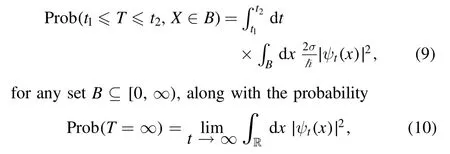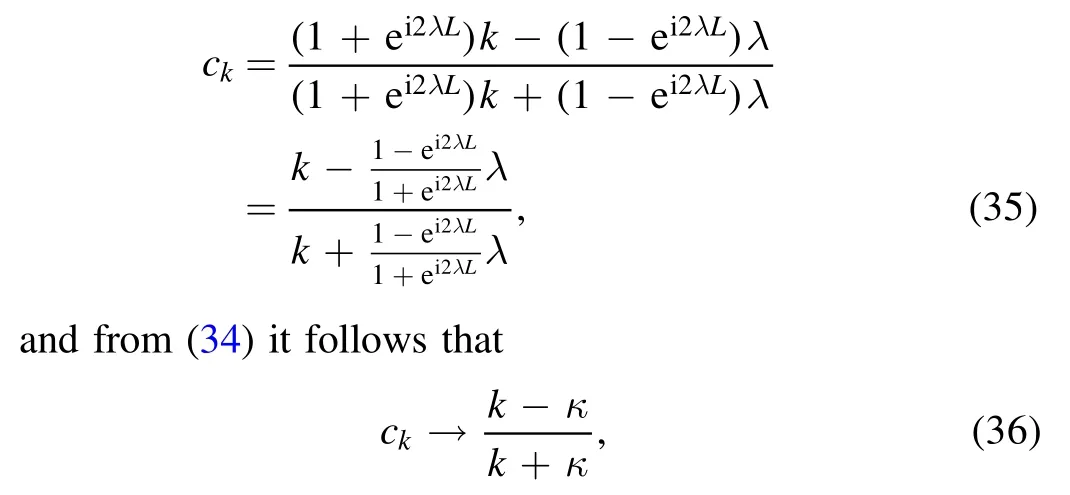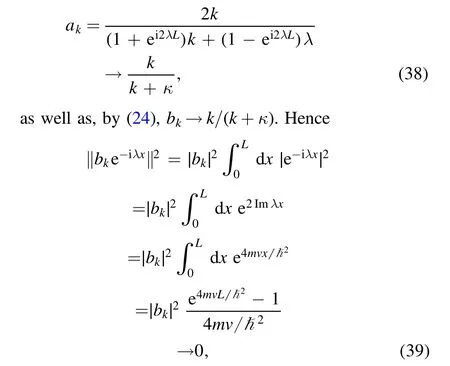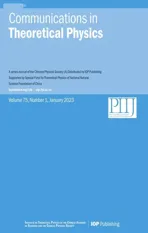Absorbing boundary condition as limiting case of imaginary potentials
2023-02-16RoderichTumulka
Roderich Tumulka
Fachbereich Mathematik,Eberhard-Karls-Universität,Auf der Morgenstelle 10,D-72076 Tübingen,Germany
Abstract Imaginary potentials such as V(x)=-iσ1Ω(x)(with σ>0 a constant,Ω a subset of 3-space,and 1Ω its characteristic function) have been used in quantum mechanics as models of a detector.They represent the effect of a‘soft’detector that takes a while to notice a particle in the detector volume Ω.In order to model a‘hard’detector(i.e.one that registers a particle as soon as it enters Ω),one may think of taking the limit σ →∞of increasing detector strength σ.However,as pointed out by Allcock,in this limit the particle never enters Ω;its wave function gets reflected at the boundary ∂Ω of Ω in the same way as by a Dirichlet boundary condition on ∂Ω.This phenomenon,a cousin of the‘quantum Zeno effect,’might suggest that a hard detector is mathematically impossible.Nevertheless,a mathematical description of a hard detector has recently been put forward in the form of the‘absorbing boundary rule’ involving an absorbing boundary condition on the detecting surface ∂Ω.We show here that in a suitable (non-obvious) limit,the imaginary potential V yields a non-trivial distribution of detection time and place in agreement with the absorbing boundary rule.That is,a hard detector can be obtained as a limit,but it is a different limit than Allcock considered.
Keywords: time observable,quantum Zeno effect,non-Hermitian Hamiltonian,time of arrival
1.Introduction
Imaginary potentials have the effect that the time evolution defined by the Schrödinger equation is no longer unitary;rather,they lead to gain or loss of |ψ|2weight,depending on whether the potential is positive or negative imaginary.Such a loss is desirable to model absorption or detection of particles[1–5].Here,we are interested in detection and consider two kinds of detectors:a‘hard’detector that registers a particle as soon as it enters the detector volume,and a‘soft’detector that takes some time to register the particle.Imaginary potentials are suitable as models of a soft detector,as discussed in particular by Allcock [4].For example,for a single,nonrelativistic quantum particle of massm>0 in 1 dimension with a soft detector in the region [0,∞),we consider the Schrödinger equation

where σ>0 is a constant(ħ/2 times the detection rate)and Θ is the Heaviside function [i.e.Θ(x)=1 forx≥0 and 0 otherwise].
Let us turn to hard detectors.The question of a detecting surface is a natural one.After all,the standard Born rule ρ(x)=|ψ(x)|2can be regarded as providing detection probabilities for detectors placed along the spacelike surfacet=const.,so the question arises,what happens if we place detectors along a timelike surface such asx1=0?The question had been considered early on;for example,Pauli [6],p.60 famously had an argument that there is no self-adjoint operator for time,and Aharonov and Bohm[7]came up with a proposal for the distribution of the detection time atx1=0,but not a convincing one.One might expect that this distribution could be obtained as a limit of a soft detector,letting the parameter σ,representing the strength of the detector,tend to ∞.However,Allcock[4]found that in this limit,for an initial wave function in 1d concentrated in the negative half axis,with probability 1 the detector never clicks,and ψt(x)=0 at allx≥0 andt≥0—a situation reminiscent of the quantum Zeno paradox [4,8–11].Similar results were found for other non-Hermitian Hamiltonians [12,13].Allcock (prematurely) concluded that a hard detector was mathematically impossible.Misra and Sudarshan[9] even wrote: ‘A watched pot never boils’—an apparently paradoxical conclusion that goes against common sense.
But a successful model of a hard detector is possible.It is provided by the ‘absorbing boundary rule’ [14,15].According to it,the wave functionψt:(-∞,0]→ Cevolves according to the free Schrödinger equation

supplemented by the ‘absorbing’ boundary condition

where k>0 is a constant(the wave number of sensitivity of the detector).For other proposed rules about the detection time distribution,see [16–23].
It is of interest now to understand all aspects of the absorbing boundary rule more closely.In particular,we would like to understand how to obtain this boundary condition as a limit of imaginary potentials.That is the topic of the present paper.It describes a relationship between two natural mathematical descriptions of detectors (soft and hard detectors,that is,imaginary potentials and absorbing boundary conditions).The obvious way of making a soft detector harder,the limit σ →∞that we will henceforth call ‘Allcock’s limit,’failed.But we describe a different,non-obvious limiting procedure in which the soft detector model (1) does approach the hard detector model given by the absorbing boundary rule(2),(3).Our derivations are not mathematically rigorous.The convergence occurs for wave functions as well as for the distribution of the detection time,specified in(9)in section 2.
We proceed as follows.Both the HamiltonianHiσof (1)with imaginary potential and the HamiltonianHikof (2),(3)with absorbing boundary condition are non-selfadjoint,and the time evolution operatorsthey define are not unitary but are contractions (i.e.∥Wtψ∥≤∥ψ∥).We compute the eigenfunctions and eigenvalues of the Hamiltonians.Since the Hamiltonians are not selfadjoint,either their eigenvalues are complex and not all real,or their eigenfunctions do not form a complete orthonormal system.We want to show that the eigenfunctions and eigenvalues ofHiσapproach those ofHikin a suitable limit.This limit involves one more modification ofHiσ: we make the detector volume a finite interval[0,L] and impose Neumann boundary conditions atL>0

The (non-selfadjoint) Hamiltonian inL2((-∞,L])defined by(1)and(4)will be denoted byHiσ,L.We claim that

while keepingm(and ħ)constant.Moreover,the distribution of the detection time converges to that of the absorbing boundary rule in the hard limit.
A different way of approaching the absorbing boundary rule through a limit has been identified by Dubey,Bernardin,and Dhar [24].Their consideration begins with a quantum particle moving on a lattice of width ε and repeated quantum measurements of the projection to Ω at time intervals of length τ,a setup similar to that of the quantum Zeno effect.The limit considered by Dubey,Bernardin,and Dhar involves first letting τ →0 while assuming the transition amplitudes in the Hamiltonian between the lattice sites of ∂Ω and their neighbors in the interior of Ω diverge like τ-1/2,and then letting ε →0 while rescaling time and ψ appropriately.
In section 2,we give more detail about the models of hard and soft detectors.In section 3,we compute their eigenvalues and eigenfunctions.In section 4,we derive the limiting statement.In section 5,we collect some remarks.In section 6,we conclude.
2.Setup of equations
2.1.Imaginary potential
The Schrödinger equation (1) with imaginary potential leads to the continuity equation

with probability current

To visualize the physical meaning of(7),we may think of the Bohmian trajectory associated with it:it is the solutionst↦X(t) of the equation of motion dX/dt=j(X)/|ψ(X)|2that has random initial conditionX(0)with|ψ0|2distribution and ends at a random time with rate (2σ/ħ)Θ(X(t));that is,whenever the particle is in the detector volume,it has probability(2σ/ħ)dtto disappear in the next dtseconds.We can think of this disappearance as an absorption due to detection.As a consequence,assuming ∥ψ0∥=1,the probability distribution of the timeTand placeXof detection (or,equivalently,of the end of the trajectory) is

that the particle never gets detected (as could happen,for example,if the particle wanders off to-∞without ever entering the detector volume).The quantity |ψt(x)|2dxrepresents the probability that the particle is located in[x,x+dx]at timet(and,in particular,has not been absorbed yet).It follows that

is the ‘survival probability,’ and since Prob(t

Should the experiment be terminated at a timetbefore the detector clicks,then the collapsed wave function is ψt/∥ψt∥.
2.2.Absorbing boundary rule
It is known [14,25],that the system (2)–(3) possesses a unique solution ψt(x) for every initial datumψ0∊L2((-∞,0]);we will assume ∥ψ0∥=1.The probability distribution of the random timeTat which the detector clicks has density ρT(t) given by the probability currentjtatx=0,that is

By virtue of the boundary condition(3),this quantity can equivalently be expressed as

which is clearly non-negative,as a probability density must be;we see in particular that the currentjt(0)is always pointing outward.Again,|ψt(x)|2dxis the probability for the presence of the particle in[x,x+dx]at timet,and the distribution ofTcan equivalently be rewritten as

Moreover,again,should the experiment be terminated at a timetbefore the detector clicks,then the collapsed wave function is ψt/∥ψt∥.
Extensions of the absorbing boundary rule to moving detectors and to several particles are described in[26],and to the Dirac equation in [27].Note also that the theory still works in the same way if we replace the boundary condition(3) by

with arbitraryσ∊R(and still k>0).The HamiltonianHσ+ikis then defined as-(ħ2/2m)∂2/∂x2with boundary condition (16).
3.Eigenvalues and eigenfunctions
3.1.Hamiltonian with imaginary potential
We aim at finding the eigenvalues and (non-normalizable)eigenfunctions ofHiσ,Ldefined by (1) and (4).

Focus first onx<0 (‘region I’);being an eigenfunction of-(ħ2/2m)∂2/∂x2means to solve an ODE inxwhose general solution has the form possibly with complexk.It seems plausible that,althoughHiσ,Lwill not be self-adjoint,only real values ofkare relevant to the eigenfunctions,asexp (ikx)withk>0 then represents an incoming wave from the left.It follows that

Let us turn to 0 with complex λ satisfying and,say,Reλ>0 (to define which of the two square roots is called λ and which-λ).The contribution that shrinks exponentially may seem plausible in view of the absorption taking place in region II;the contribution that grows exponentially may be thought of as reflected atL. It also seems plausible that the eigenfunctions should satisfy matching conditions The Neumann boundary condition (4) atLimplies that From these three relations (23),(24) together,we obtain that We also note for later use the explicit expression forak, We now aim at finding the eigenvalues and eigenfunctions ofHσ+ik,defined by the Schrödinger equation (2) and the absorbing boundary condition in the more general version(16).Again,eigenfunctions must be of the form (17),and again,kshould be real,without loss of generality positive,anddkcan be taken to be 1,so the eigenfunction is again of the form (19) with real eigenvalue given by (18).This time,the coefficientck∊C must be chosen so that(16)is satisfied,i.e.ik(1-ck)=(σ+ik)(1+ck) or In this case,there is no region II. The eigenfunctionsf(x) contain a right-moving wave eikx(k>0) coming from-∞and a reflected wavecke-ikxcoming from the right boundary(at 0)and moving to the left.The absolute square ofckprovides the reflection coefficient [28] or idealized probability of reflection at this value ofk;the absorption coefficient isAk=1-Rk.As discussed in[15],anabsorbing boundarymeans that the particle gets absorbed there,but not necessarily (or not completely) the wave.Perfect absorption,Ak=1,is reached whenRk=0 orck=0,and by (27) this occurs forHσ+ikwhenever Sincekis real,this situation can only occur when σ=0,and that is why anidealdetector was assumed to have σ=0 in [15]. The simplest situation in which we can consider Allcock’s limit has no right boundary,L=∞.The eigenvalues and eigenfunctions for this situation can actually be obtained from the formulas of section 3.1 in the limitL→∞.Fix σ>0 andk>0;since λ2has phase between 0 and π/2 and thus λ between 0 and π/4,we know that λ has a positive imaginary part,with the consequence that asL→∞,eiλL→0 and ei2λL→0.Thus,bk→0,so the exponentially growing contribution tofIIdisappears and,in the limitL→∞ Now take Allcock’s limit σ →∞.Since|λ2|→∞,also|λ|→∞,so In particular,the reflection coefficient is 1 and the absorption coefficient 0.As Allcock found,the probability that the particle ever gets detected (and thus absorbed) is 0. In fact,in the limit σ →∞alsoak→0,sofII(x)→0 for everyx>0,so the probability of the particle ever entering the detector volume is 0.Sinceck→-1 which are the eigenfunctions of the Schrödinger equation on(-∞,0] with a Dirichlet boundary condition We now consider the hard limit(6)and show thatHiσ,L→Hikwith σ=0 in the sense that the eigenfunctions and eigenvalues converge. Our first claim is that in this limit,for anyk>0 Indeed,λ2→i ∞,λ →(1+i)∞,λ2L→ik,λL→0,ei2λL→1,and (1-ei2λL)λ ≈(-i2λL)λ=-i2λ2L→2k,which implies (34). Now (25) can be rewritten as which agrees with (27),theckof the absorbing boundary condition(16)with σ=0.Thus,fIconverges to thefIofHik. In order to show that for any givenk>0,the eigenfunction ofHiσ,Lconverges to that ofHik,we need to verify thatfIIdisappears in the hard limit.While the interval [0,L]shrinks to a point,it is not as obvious that To see that this is indeed the case,note that,by (26) and the relations mentioned between (34) and (35) sincebkstays bounded,vL→ħ2k/2mstays bounded,and σ →∞.In a similar way,one can see that also ∥akeiλx∥→0,so that ∥fII∥→0,as claimed. We thus have that the eigenfunctions converge,while the eigenvalue is the same,viz.,(18).That is,Hiσ,L→Hikin the hard limit.It is thus also plausible thatand that ψtconverges accordingly for every fixedt. Our further claim that the distribution density ρTof the detection timeTconverges to that of the absorbing boundary rule is then suggested by the fact that in both settings(the imaginary potential and the absorbing boundary),ρT(t)=-d∥ψt∥2/dt,see(12) and (15). 1.Higher dimension.Our analysis of the hard limit carries over directly to the case in which the detector volume is{(x1,…,xd):0 2.General shapes in higher dimension.It seems plausible that the hard limit still yields the absorbing boundary rule for more general shapes of the detecting surface,as the limitL→0 focuses on small length scales,on which a curved surface looks flat;also surfaces with edges (such as that of a cube) seem unproblematical since the probability current into the edges will be negligible.It also seems very plausible that the joint probability distribution of the detection timeTand the detection location X approaches that of the absorbing boundary rule. 3.Robin condition.The hard limit still agrees with the absorbing boundary rule if we replace the Neumann condition (4) with a Robin condition with arbitrary constantα∊R,but not if we replace it with a Dirichlet condition ψ(L)=0.That is because,for a Robin condition,the factor ex p (i 2λL)gets replaced byand any limit involving σ →∞entails that λ →(1+i)∞,,and the limiting behavior of (25) is the same as in the Neumann case α=0.In the Dirichlet case,however,exp (i 2λL)gets replaced by -e xp (i 2λL),and(34)cannot pos sibly hold with the opposite signs because the growth of λ requires,in view of the bounded denominator in (34),that the numerator 1 +exp (i 2λL)tends to 0,but that cannot occur because λLmust approach a positive multiple of 1+i.However,(34)is necessary,in view of(35),for (36) to hold. 4.Finite interval.Consider now a finite interval,which it will be convenient to take to be [-ℓ,0],with the absorbing boundary condition(16)at 0 and,for example,a Dirichlet boundary condition at-ℓ,ψ(-ℓ)=0.Then the eigenfunctions are still of the form(19),but they need to satisfy in addition e-ikℓ+ckeikℓ=0 or which restricts the possiblekvalues to a discrete set and forces them to become complex,resulting in complex eigenvalues (18)with negative imaginary parts.The same consequence,discrete complex eigenvalues,would occur for the imaginary potential as in (1) on the interval [-ℓ,L] with boundary conditions at-ℓ andLsuch as Dirichlet at-ℓ and Neumann atL.The eigenfunctionsfare now square-integrable,and the complex eigenvalues ω=E-iμ (withE∊ R ,μ>0)ensure that shrinks with time.I expect that also in this situation the Hamiltonian with imaginary potential converges in the hard limit (6) (keeping ℓconstant) to the one with absorbing boundary condition with σ=0;a careful study of this question would be of interest. The question of how to mathematically represent a detecting surface has long been mysterious,and attempts to define it through a limit of imaginary potentials originally failed.Now that such a mathematical representation is available in the form of an absorbing boundary condition,we have identified in this paper a particular limit of an imaginary potential that leads to this boundary condition: let the thicknessLof a detecting layer tend to 0 and the strength σ of the imaginary potential in this layer to infinity in such a way that the productvLremains finite,and impose a Neumann or Robin boundary condition on the back wall of the layer.We have derived(non-rigorously) that in this limit,the HamiltonianHiσ,Lwith this imaginary potential converges to the HamiltonianHikwith an absorbing boundary condition,in the sense that the eigenvalues and eigenfunctions ofHiσ,Lconverge to those ofHik.The fact that neitherHiσ,LnorHikis Hermitian means that both allow the particle to be absorbed. Acknowledgments I thank Stephen Shipman for helpful discussions. ORCID iDs





3.2.Hamiltonian with absorbing boundary condition

3.3.Reflection coefficient

4.Limiting cases
4.1.Allcock’s limit




4.2.Hard limit




5.Remarks



6.Conclusions
杂志排行
Communications in Theoretical Physics的其它文章
- Modification of laser-induced state in atomic attosecond transient absorption by the XUV pulse pair
- Thermoelectric transport in holographic quantum matter under shear strain
- High-sensitive refractive index sensing and excellent slow light based on tunable triple plasmon-induced transparency in monolayer graphene based metamaterial
- Optical forces on neutral atoms in the presence of fluctuating laser fields:numerical analysis
- Thermal Hall conductivity with sign change in the Heisenberg–Kitaev kagome magnet
- A numerical method to calculate dwell time for electron in semiconductor nanostructure
